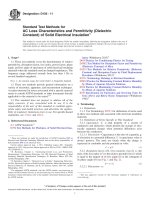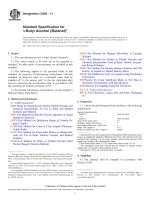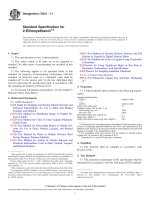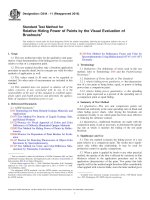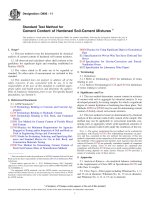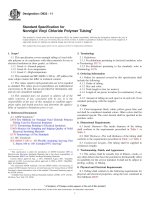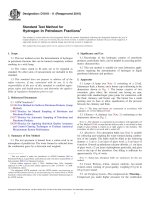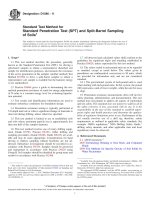Astm d 806 11
Bạn đang xem bản rút gọn của tài liệu. Xem và tải ngay bản đầy đủ của tài liệu tại đây (84.74 KB, 4 trang )
Designation: D806 − 11
Standard Test Method for
Cement Content of Hardened Soil-Cement Mixtures
1
This standard is issued under the fixed designation D806; the number immediately following the designation indicates the year of
original adoption or, in the case of revision, the year of last revision. A number in parentheses indicates the year of last reapproval. A
superscript epsilon (´) indicates an editorial change since the last revision or reapproval.
D6026 Practice for Using Significant Digits in Geotechnical
Data
E11 Specification for Woven Wire Test Sieve Cloth and Test
Sieves
E145 Specification for Gravity-Convection and ForcedVentilation Ovens
E832 Specification for Laboratory Filter Papers
1. Scope*
1.1 This test method covers the determination by chemical
analysis of cement content of hardened soil-cement mixtures.
1.2 All observed and calculated values shall conform to the
guidelines for significant digits and rounding established in
Practice D6026.
1.3 The values stated in SI units are to be regarded as
standard. No other units of measurement are included in this
standard.
1.4 This standard does not purport to address all of the
safety concerns, if any, associated with its use. It is the
responsibility of the user of this standard to establish appropriate safety and health practices and determine the applicability of regulatory limitations prior to use. For specific hazard
precautions, see Section 6.
3. Terminology
3.1 Definitions:
3.1.1 Refer to Terminology D653 for definitions of terms
relating to soil.
3.1.2 Refer to Terminologies C125 and C219 for definitions
of terms relating to cement.
4. Significance and Use
4.1 This test method determines cement content in mixtures
of cement with soil or aggregate by chemical analysis. It was
developed primarily for testing samples for which a significant
degree of cement hydration or hardening has taken place. Test
Methods D2901 or D5982 may be used for determining cement
content of freshly mixed soil-cement mixtures.
2. Referenced Documents
2.1 ASTM Standards:2
C125 Terminology Relating to Concrete and Concrete Aggregates
C219 Terminology Relating to Hydraulic Cement
D653 Terminology Relating to Soil, Rock, and Contained
Fluids
D2901 Test Method for Cement Content of Freshly Mixed
Soil-Cement
D3740 Practice for Minimum Requirements for Agencies
Engaged in Testing and/or Inspection of Soil and Rock as
Used in Engineering Design and Construction
D4753 Guide for Evaluating, Selecting, and Specifying Balances and Standard Masses for Use in Soil, Rock, and
Construction Materials Testing
D5982 Test Method for Determining Cement Content of
Fresh Soil-Cement (Heat of Neutralization Method)
4.2 This test method is based on determination by chemical
analysis of the calcium oxide (CaO) content of the sample. The
method may not be applicable to soil-cement materials containing soils or aggregates which yield significant amounts of
dissolved calcium oxide (CaO) under the conditions of the test.
NOTE 1—The agency performing this test method can be evaluated in
accordance with Practice D3740. Not withstanding statements on precision and bias contained in this test method: the precision of this test
method is dependent on the competence of the personnel performing it and
the suitability of the equipment and facilities used. Agencies that meet the
criteria of Practice D3740 are generally considered capable of competent
and objective testing. Users of this test method are cautioned that
compliance with Practice D3740 does not, in itself, ensure reliable testing.
Reliable testing depends on many factors; Practice D3740 provides a
means of evaluating some of these factors.
1
This test method is under the jurisdiction of ASTM Committee D18 on Soil and
Rock and is the direct responsibility of Subcommittee D18.15 on Stabilization With
Admixtures.
Current edition approved Nov. 1, 2011. Published January 2012. Originally
approved in 1944. Last previous edition approved in 2006 as D806–00(2006). DOI:
10.1520/D0806-11.
2
For referenced ASTM standards, visit the ASTM website, www.astm.org, or
contact ASTM Customer Service at For Annual Book of ASTM
Standards volume information, refer to the standard’s Document Summary page on
the ASTM website.
5. Apparatus
5.1 Analytical Balance—An analytical balance conforming
to the requirements of Class GP2 in Specification D4753 and
with Class S weights.
5.2 Filter Paper—Filter paper including Whatman No. 1, 11
and 15 cm in diameter; Whatman No. 41, 15 cm in diameter;
and Whatman No. 2, 11 or 15 cm in diameter.
*A Summary of Changes section appears at the end of this standard
Copyright © ASTM International, 100 Barr Harbor Drive, PO Box C700, West Conshohocken, PA 19428-2959. United States
1
D806 − 11
7.1.3 Soil-cement Mixture to be analyzed.
5.3 Fifty-Millilitre-Pipet.
5.4 Drying Oven—Thermostatically controlled, preferably
of the forced-air type, meeting the requirements of Specification E145 and capable of maintaining a uniform temperature of
110 6 5°C throughout the drying chamber.
7.2 The gross laboratory sample of each component shall be
approximately 200 g. This may be obtained by reducing the
sample in bulk and, if necessary, in particle size through the use
of drying, riffling and grinding processes.
5.5 Miscellaneous Apparatus—Supplementary equipment,
such as electric ovens, hot plates, a small riffle, a No. 40- (425
µm-) sieve with bottom pan and cover, a cast iron mortar and
pestle, and a ball mill if possible.
8. Procedure
8.1 Dry 25 g of each of the samples in an oven to constant
mass at 110 6 5°C (230 6 9°F) to remove free water. Reduce
the samples to pass a No. 40- (425 µm-) sieve.
6. Reagents
8.2 Using an analytical balance, prepare the following
amounts for each of the samples: raw soil, 5 g; soil-cement
mixture, 5 g; and cement, 1 g. Place each of the weighed
samples in a 250-mL beaker. Add 50 mL of HCl (1 + 1) (Note
3) to each sample, cover, and boil gently for 5 min on the hot
plate.
6.1 Purity of Reagents—Reagent grade chemicals shall be
used in all tests. Unless otherwise indicated, it is intended that
all reagents shall conform to the specifications of the Committee on Analytical Reagents of the American Chemical Society,
where such specifications are available.3 Other grades may be
used, provided it is first ascertained that the reagent is of
sufficiently high purity to permit its use without lessening the
accuracy of the determination.
NOTE 3—In the case of the cement sample, it is usually preferable first
to add 25 mL of water and then stir to obtain a thorough mixture. Then add
25 mL of HCl (sp gr 1.19) and boil gently just long enough to obtain
decomposition of the cement. Vigorous or extended boiling of soil or
cement samples is seldom necessary, and often results in much slower
filtration.
6.2 Potassium Permanganate, Standard Solution (0.1 N)—
Prepare a 0.1 N KMnO4 solution and standardize against
primary standard grade oxalic acid, sodium oxalate or iron (II)
ammonium sulfate hexahydrate.
8.3 Add 25 mL of hot water to the beakers, stir, allow to
settle momentarily, and then decant the contents through a
Whatman No. 1 filter paper (Note 4), preferably 15 cm in
diameter. The filtrate should be received in a 250-mL volumetric flask. When the liquid has passed through the filter paper,
wash the residue once by decantation, using hot water; then
transfer it to the filter, using a stream of hot water. The beaker
should be rapidly policed, the loosened material being transferred to the filter paper. The material on the filter should then
be washed an additional four times, each washing consisting of
10 to 15 mL of hot water directed in a stream from the wash
bottle. Very small amounts of residue will occasionally pass
through the filter. These ordinarily may be disregarded.
NOTE 2—The use of a standard 0.1 N KMnO4 solution is not necessary
when the samples are titrated in accordance with 8.9 and the results are
calculated in accordance with 9.2. However, the actual reagent concentration must be determined by titration against primary standard grade
oxalic acid, sodium oxalate or iron (II) ammonium sulfate hexahydrate.
6.3 Ammonium Nitrate Solution—Dissolve 20 g of NH4NO3
in 1L of distilled water.
6.4 Hydrochloric Acid (1 + 3)—Add 200 mL of HCl (sp gr
1.19) to 600 mL of distilled water.
6.5 Hydrochloric Acid (1 + 1)—Add 25 mL of HCl (sp gr
1.19) to 25 mL of distilled water.
6.6 Nitric Acid—See Note 3.
NOTE 4—In the case of the soil and soil-cement samples, the bulk of the
residue sometimes slows filtration appreciably. No difficulty is usually
encountered from cement samples, and, as a rule, soil samples may be
filtered and washed in less than 30 min. Some soil-cement mixtures
require more time, but, if this period exceeds 1 h, subsequent filtration in
similar cases may be more rapid if a No. 41 paper is substituted for the No.
1 paper. Slow filtration in such cases is generally caused by excessive
boiling, resulting in gelation of the silica, which materially retards
filtration.
6.7 Ammonium Oxalate Solution (5 %) —50 g of ammonium oxalate. (Warning —In addition to other precautions,
this is done by adding the acid, slowly while stirring, to the
water to avoid a sudden temperature rise that could cause
boiling and spattering of the acid solution.)
6.8 Ammonium Hydroxide, NH4OH (sp gr 0.90).
6.9 Sulfuric Acid (1 + 1)—Add 500 mL H2SO4 (sp gr 1.84)
to 500 mL of distilled water.
8.4 When washing has been completed, discard the filter,
and dilute the filtrate in the volumetric flask to 250 mL with
cold water. The temperature of the solution should be near the
calibration point of the flask. Agitate the flask to mix the
contents thoroughly, then remove a 50-mL aliquot and transfer
to the original 250-mL beaker (8.2), using a 50-mL pipet.
Dilute to 100 mL. Make the solution slightly ammoniacal
(Note 5) by dropwise addition of ammonium hydroxide, boil 1
to 2 min, and allow the hydroxides to settle.
7. Samples
7.1 Samples of the following shall be selected for the test:
7.1.1 Raw Soil, representative of the soil phase of the
soil-cement mixture.
7.1.2 Cement, representative of the cement phase of the
soil-cement mixture, and
NOTE 5—If the samples contain ferrous iron it is desirable to add a few
drops of HNO3 before precipitation of the hydroxides. Also, pH paper can
be used to assure that enough ammonium hydroxide has been added.
3
“Reagent Chemicals, American Chemical Society Specifications,” American
Chemical Society, Washington, DC. For suggestions on the testing of reagents not
listed by the American Chemical Society, see “Reagent Chemicals and Standards,”
by Joseph Rosin, D. Van Nostrand Co., Inc., New York, NY, and the “United States
Pharmacopeia.”
8.5 Filter the hydroxides through an 11-cm Whatman No. 1
(or No. 41) filter paper, receiving the filtrate in the 600-mL
2
D806 − 11
N solution, but the same solution shall be used in titrating all
the components. Omit the blank determination described in
8.8.
beaker. Wash the original 250-mL beaker into the filter once
with a stream of hot NH4NO3 solution (20 g/L), and follow by
washing the hydroxide precipitate once or twice with hot
NH4NO3 solution (20 g/L). Set the filtrate aside, and place the
original beaker under the funnel. Perforate the paper with a rod
(Note 6), and wash the hydroxides down into the original
beaker, using a stream of hot NH4NO3 solution (20 g/L) to
remove most of the precipitate from the filter paper. Treat the
paper with 20 mL of hot HCl (1 + 3), directing the acid over the
paper with a glass rod. Wash the paper several times with hot
water, and then discard the paper. Dilute the solution to 75 mL.
9. Calculation
9.1 Calculate the cement content of the soil-cement mixture
as follows:
9.1.1 When the determination has been completed in accordance with 8.7 and 8.8:
9.1.1.1 Calculate the percentages of CaO in the soil, the
cement, and the soil-cement mixture as follows:
NOTE 6—Instead of perforating the filter paper, the paper and precipitate may be transferred to the original beaker, the hydroxides dissolved
with 20 mL of hot HCl (1 + 3) and diluted to 75 mL with water, and the
procedure continued as described in 8.6. In this case, the reprecipitated
hydroxides and pulp are subsequently removed simultaneously.
CaO, % 5 @ ~~ A 2 B ! C 3 0.028! /D # 3 100
(1)
where:
A
= KMnO4 solution required for titration of the
sample, mL,
B
= KMnO4 solution required for titration of the blank,
mL,
C
= normality of the KMnO4 solution,
D
= sample represented by the aliquot titrated (Note
10), g, and
0.028 = CaO equivalent of 1 mL of 1.0 N KMnO4 solution.
8.6 Make the solution slightly ammoniacal and boil 1 to 2
min. Allow the precipitate to settle, then decant through a
Whatman No. 1 paper as before, receiving the filtrate in the
600-mL beaker previously set aside (8.5). Wash and police the
beaker in which precipitation took place, finally washing the
precipitate on the filter three or four times with NH4NO3
solution (20 g/L). Discard the hydroxide precipitate. Add 2 mL
of NH4OH (sp gr 0.90) to the filtrate, which will now have a
volume of 250 to 350 mL. Heat the solution to boiling and add
10 mL of hot saturated ammonium oxalate solution. Keep the
mixture near boiling until precipitate becomes granular; then
set aside on a warm hot plate for 30 min or more. Before
filtering off the calcium oxalate, verify completeness of precipitation, (Note 7) and make sure that a slight excess of
NH4OH is present. Filter the mixture through an 11-cm or
15-cm Whatman No. 2 filter paper, or if preferred a Whatman
No. 42 paper, making sure that all the precipitate is being
retained. Thoroughly clean with a rubber policeman the beaker
in which precipitation took place, and transfer the contents to
the filter with a stream of hot water. Wash the filter eight to ten
times with hot water (not over 75 mL) (Note 8), using a stream
from the wash bottle.
9.1.1.2 Calculate the percent cement by mass of soil as
follows (Note 11):
Cement, % 5 @ ~ G 2 F ! / ~ E 2 F ! # 3 100
(2)
where:
E = CaO in cement, %,
F = CaO in raw soil, %, and
G = CaO in soil-cement mixture,% .
NOTE 10—The aliquots titrated are equivalent to 1 g of soil or
soil-cement and 0.2 g of cement.
NOTE 11—The value for percentage by mass of soil obtained in
accordance with 9.1 or 9.2 is in terms of hydrated cement. Such values
may be converted to an approximate equivalent of dry cement by
multiplying them by the factor 1.04.
9.2 When the determination has been completed in accordance with 8.9, calculate the percent cement by mass of soil as
follows (Note 11):
NOTE 7—The calcium oxalate precipitation is sometimes not complete
and this results in low CaO values. The precipitation operation must be
carried out with thoroughness and care.
NOTE 8—The filter may be washed four times each with NH4OH
(2 + 98) and hot water, in the order stated.
Cement, % 5 @ ~ J 2 I ! / ~ 5H 2 I ! # 3 100
(3)
where:
H = KMnO4 solution required for titration of the sample of
cement, mL,
I = KMnO4 solution required for titration of the sample of
raw soil, and mL,
J = KMnO4 solution required for titration of the sample of
soil-cement mixture, mL.
8.7 Carefully open the filter paper and wash the precipitate
into the beaker in which the precipitation was effected. Dilute
to 200 mL and add 10 mL of H2SO4 (1 + 1). Heat the solution
just short of boiling, and titrate it with the standard KMnO4
solution (Note 9) to a persistent pink color. Add the filter paper
and macerate it. Continue the titration slowly until the pink
color persists for 10 s.
10. Precision and Bias
NOTE 9—The temperature of the standard KMnO4 solution should not
vary from its standardization temperature so much as to cause a serious
error in the determination of CaO. At ordinary room temperatures the
volume of pure water changes to the extent of 0.01 to 0.04 % for each
degree Celsius, depending on the temperature.
10.1 Precision—Test data on precision is not presented due
to the nature of the soil materials being tested by this test
method. It is either not feasible or too costly at this time to have
ten or more laboratories participate in a round-robin testing
program.
10.1.1 Subcommittee D18.15 is seeking any data from the
users of this test method that might be used to make a limited
statement on precision.
8.8 Blank—Make a blank determination, following the same
procedure and using the same amounts of all reagents.
8.9 Alternative Titration Procedure—Titrate as described in
8.7, except that the KMnO4 solution need not be a standard 0.1
3
D806 − 11
10.2 Bias—There is no accepted reference value for this test
method, therefore, bias cannot be determined.
11. Keywords
11.1 cement content; durability; soil-cement; soil-cement
mixtures; soil stabilization
SUMMARY OF CHANGES
Committee D18 has identified the location of selected changes to this test method since the last issue,
D806–00(2006), that may impact the use of this test method. (Approved November 1, 2011)
(4) Added additional alternative to Note 5 for assuring sufficient ammonium hydroxide addition.
(1) Revised 6.2 to clarify the standardization of KMnO4.
(2) Clarified Note 2.
(3) Revised 8.4 by adding method to make solution ammoniacal.
ASTM International takes no position respecting the validity of any patent rights asserted in connection with any item mentioned
in this standard. Users of this standard are expressly advised that determination of the validity of any such patent rights, and the risk
of infringement of such rights, are entirely their own responsibility.
This standard is subject to revision at any time by the responsible technical committee and must be reviewed every five years and
if not revised, either reapproved or withdrawn. Your comments are invited either for revision of this standard or for additional standards
and should be addressed to ASTM International Headquarters. Your comments will receive careful consideration at a meeting of the
responsible technical committee, which you may attend. If you feel that your comments have not received a fair hearing you should
make your views known to the ASTM Committee on Standards, at the address shown below.
This standard is copyrighted by ASTM International, 100 Barr Harbor Drive, PO Box C700, West Conshohocken, PA 19428-2959,
United States. Individual reprints (single or multiple copies) of this standard may be obtained by contacting ASTM at the above
address or at 610-832-9585 (phone), 610-832-9555 (fax), or (e-mail); or through the ASTM website
(www.astm.org). Permission rights to photocopy the standard may also be secured from the ASTM website (www.astm.org/
COPYRIGHT/).
4
